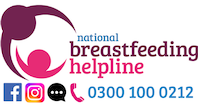This information can also be viewed as a PDF by clicking here.
The information provided is taken from various reference sources. It is provided as a guideline. No responsibility can be taken by the author or the Breastfeeding Network for the way in which the information is used. Clinical decisions remain the responsibility of medical and breastfeeding practitioners. The data presented here is intended to provide some immediate information but cannot replace input from professionals.
Constipation is defined as difficulty in passing bowel motions, which may be described as hard, infrequent or changed in volume and/or consistency. Frequently constipation is caused by a change in diet or by medication. Individual experiences of bowel motions are subjective but constipation affects many people at some time in their lives. It is common towards the end of pregnancy and following pain relief for childbirth when it may be particularly difficult due to perineal stitches. For further information see www.patient.co.uk/health/constipation-in-adults-leaflet
The first remedy should be to increase fruit, vegetable and fibre intake, along with additional water consumption. Exercise may also help to relieve symptoms. If the mother is taking an analgesic (pain relief) medication containing codeine e.g. co-codamol, co-dydramol, this should be stopped and paracetamol and/or a non-steroidal drug such as ibuprofen or diclofenac substituted. If codeine is needed it can be given as a separate tablet of codeine phosphate 15milligrammes and added in as needed to relieve the pain. However, where a medication is required to resolve constipation during breastfeeding, osmotic or bulk laxatives are preferable, at least initially, to stimulant laxatives. Bulk Laxatives are particularly useful where stools are small and hard. However there may be a delay of up to 72 hours before they exert their full effect. Bulk laxatives absorb water within the gut and swell to produce a greater volume of soft stool which is easier to pass e.g. Fybogel®, Regulan®, Isogel®, Normacol®. Absorption of bulk laxatives is minimal and they can all be used during breastfeeding.
Osmotic laxatives work by increasing the amount of fluid in the large bowel. These also have a delay in action but it is generally shorter than bulk laxatives. They help to produce softer bowel movements, which are easier to pass. E.g. Magnesium Hydroxide, Magnesium Sulphate, Lactulose, Movicol ®. Passage of osmotic laxatives into breastmilk is low and they can all be used during breastfeeding.
Stimulant laxatives should not be used routinely by anyone as they can lead to a reliance on their action. They may cause evacuation of all bowel contents, which then need to re-build before a regular normal bowel action is resumed. They are however, useful for occasional use. They have a more rapid onset of action than bulk or osmotic laxatives, and are usually given at night to help produce a bowel motion the following morning e.g. Senna (Senokot® Ex Lax®,) Bisacodyl (Dulcolax®), Sodium Picosulphate (Laxoberal®, Picolax®).
Side effects in breastfeeding infants have not been proven although loose bowel motions have been reported even with undetectable levels of senna in breastmilk.
Bibliography
- British National Formulary
- Hale T. W Medications in Mothers Milk
- Jones W Breastfeeding and Medication 2018 Routledge
- Lactmed website http://toxnet.nlm.nih.gov/cgi-bin/sis/htmlgen?LACT
- Martindale, the Extra Pharmacopia 2007
©Dr Wendy Jones MBE, MRPharmS and the Breastfeeding Network Sept 2019

